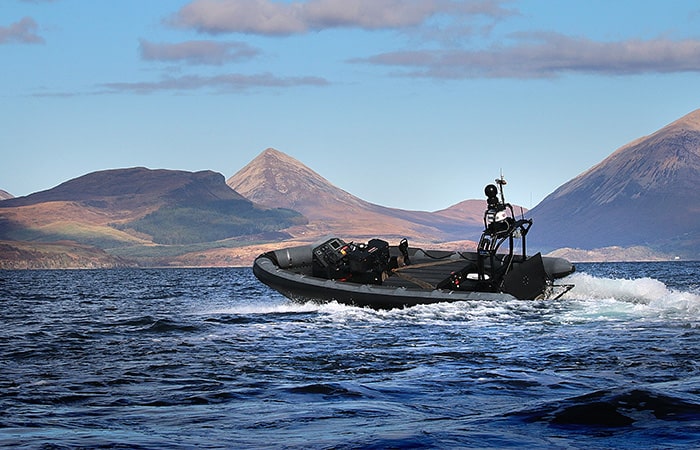AE’s technology director talks to Jon Excell about the engineering challenges of keeping one step ahead of a constantly evolving range of military threats
While they may sound like the ingredients of an action movie, AI-enabled cyberattacks, hypersonic missiles, laser cannons and robot swarms are just a few of the potential real-life threats being anxiously contemplated by the world’s top defence researchers.
In fact, at a time of rapid technological change and increasing geopolitical uncertainty, the range of threats facing countries is perhaps broader and more challenging than at any time in history.

To gain a greater understanding of the engineering challenges presented by all of this, The Engineer sat down with Dave Short (pictured left), technology director of one of the firms at the forefront of innovation in the sector: UK defence giant BAE Systems.
Disarmingly affable and relaxed given the sobering nature of the day job, Short is nevertheless clearly passionate about the task at hand: ensuring that no stone is left unturned in the search for technology. “We’re looking at anything and everything to do with technology,” he said. “Anything that can give us greater capability or competitive edge.”
Prior to taking on his current role in January 2018, Short’s career was spent predominantly within the military air sector. Most recently he was engineering authority for the Typhoon and Tornado, and before that was chief engineer for BAE’s involvement in the F-35. But, despite this focus on aerospace, interfaces in the firm and a keen interest in competitive environments have, he claims, set him up well to take on a broader tech brief.
This is important, because encouraging collaboration across a company where expertise has historically been a little ‘siloed’ is a key element of the role. “I’m trying to ensure that from a collaboration point of view we understand what we’ve already got, ensure that we maximise the technologies we already have, and ensure that we don’t duplicate,” he said.
One of the ways that the CTO organisation for which Short works achieves this is with a ring-fenced pot of ‘seed-corn’ funding that can be used to overcome some of the bureaucratic hurdles that sometimes hold up innovation.
This approach enables the firm to be a little more speculative than is often the case and to second-guess future capability requirements. “You’ve got to look further ahead, become ever more competitive and understand what the export market is going to require before they ask for it,” explained Short.
A good example of this bearing fruit is the Unmanned Warrior project, in which BAE worked with other partners to develop autonomous capabilities for the Royal Navy. “This was a more risky project when it started than was comfortable for the maritime business to take on without some backing from the centre,” he said. “But now that’s matured into something that’s progressing into bringing in customer funding.”

Another case of the firm looking to the future is its £20.6m investment in Oxfordshire’s Reaction Engines, which is developing SABRE, a new class of aerospace engine that combines jet and rocket technologies.
Short said that while BAE’s interest in the project is “very much based around opportunities for space”, the capabilities the team is developing – notably the ability to sink vast amounts of heat – could be applied to a number of other applications.
Short’s team is looking beyond BAE for inspiration, whether through its strategic relationships with universities such as Manchester (which is playing a key role in its development of unmanned aerial vehicles (UAVs) with characteristics such as non-moving surfaces) or by working with other companies. This often involves working with specialists from other sectors, and Short singled out motorsport, famed for its ability to move rapidly from prototype to finished product partner.
The firm has a longstanding relationship with McLaren and last year announced a tech sharing partnership with Williams with whom it is reported to be collaborating on cockpit designs and battery technology.
The company also frequently finds itself collaborating with competitors – an essential dynamic, he said, given the sheer range of challenges the sector faces. “When I started back in the 80s, almost everything was done in-house, but as the world moves on and there’s more technology available, you want to bring in as much as you can.”
In a sector where emerging technology areas frequently call for non-traditional skill-sets, collaboration is also at the heart of the company’s approach to people, with it often making more sense to tap into skills which exist elsewhere rather than develop an in-house capability. A case in point is the gaming sector, which is proving to be a valuable source of in-demand data expertise. “Some of the capabilities which have been developed in the gaming industry and the engines which drive those are quite suitable for some of the things we want to try and do going forward,” said Short.
“You’ve got to look further ahead, become ever more competitive and understand what the export market is going to require before they ask for it”
One of the threats driving this requirement is the growing issue of cyberattacks. “This wasn’t even mentioned in defence policy going back to 2007/08. Now it’s a major topic,” said Short, citing the 2018 WannaCry ransomware hack (which cost the NHS £92m) as an example of the havoc that can be caused. And while he wouldn’t be drawn on details of BAE’s work in this field, his thoughts on how the technology might evolve are chilling. “The thing I’ll be interested to see evolve personally is the use of AI in conjunction with cyber.
“The AI will keep learning from what didn’t work and you might find it learns more quickly than the human hacker.”
But despite justified concerns over the threat of cyber, Short rejects the notion that conventional defence projects are no longer relevant in the age of digital warfare. “The fact that you’ve got cyber doesn’t suddenly supersede the need for being able to have a really significant force on the back of an aircraft carrier somewhere, for other threats and other reasons.”
One such threat is the emergence of hypersonics, and, in particular, growing concerns over the technology being developed by Russia and China. “You’ve got intercept missiles which can take things out at Mach 3 and 4 but if something’s coming in at Mach 6, 7, and 8, what do you do about it?” he asked.
He said a key project for BAE is the Boeing-led HIFIRE programme which has been developing and trialling experimental hypersonic vehicle technology.
Elsewhere, perhaps one of BAE’s most publicised areas of activity is its work on UAVs.
From the development of the Taranis unmanned combat aircraft, to its ongoing work on flapless flight (which recently saw the firm’s Magma UAV become the first aircraft to perform manoeuvres using supersonically blown air), the pace of development has led some to speculate that the current generation of military aircraft will be the last to feature a pilot.
But while UAVs will undoubtedly play an ever-greater role, Short thinks that there will be a “man in the loop” for some time to come. “It’s a mandatory aspect of engagement anyway, but also humans still provide a flexibility that is very difficult to truly replicate through the use of autonomous systems,” he said.
He suggested the next generation will see an optionally manned capability – something being considered with Tempest, the next generation fighter concept unveiled by the firm at the 2018 Farnborough Airshow.

Tempest, a real showcase for emerging defence technologies, may also be the recipient of another system more readily associated with the movies: the directed-energy weapon. Short confirmed that this technology is an area of great interest for BAE, adding that having an infinite magazine (i.e. a weapon that doesn’t run out of bullets) would be useful for dealing with threats such as swarm attacks.
Rather than developing the actual weapons, the prime focus here, he said, is understanding the challenge of integrating this kind of technology on future platforms. “If you think about the amount of energy, the amount of heat that can be generated and some of the peripheral aspects of having that kind of capability, you need to have a design case that allows that to be part of the thought process right from the very start.”
Ultimately, this view on integration, and designing platforms to cope with future technologies, is one of the key challenges. Obsolescence has been a longstanding issue across the military environment, with numerous cases of capabilities being developed which are obsolete before they’ve gone into service.
But Short believes technology is enabling the sector to become better at future-proofing its systems. “Computing, communications, data backplanes and the way you can make things more modular means we’re in a better position to make things more future-proof even though the cycles are picking up pace all the time.”
Dave Short will be talking at Day One of The Engineer’s 2019 Conference (4-6 June, NEC, Birmingham)
MORE ON DEFENCE & SECURITY AND AEROSPACE




Nanogenerator consumes CO2 to generate electricity
Nice to see my my views being backed up by no less a figure than Sabine Hossenfelder https://youtu.be/QoJzs4fA4fo